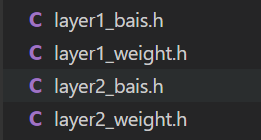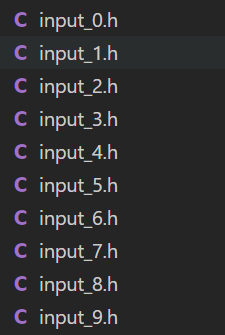python+tensorflow对mnist数据集的神经网络训练和推理 加参数提取 简易版
一、数据集的获取
from tensorflow_core.examples.tutorials.mnist import input_data
from scipy import misc
import numpy as np
import os
#获取数据集
mnist = input_data.read_data_sets("mnist_data/",one_hot=True)
#创建train的文件夹 存放训练图片
if not os.path.exists("train"):
os.mkdir("train")
#创建test的文件夹 存放测试图片
if not os.path.exists("test"):
os.mkdir("test")
for(idx,img) in enumerate(mnist.train.images):
img_arr = np.reshape(img,[28,28])
misc.imsave("train/train_"+str(idx)+".bmp",img_arr)
for(idx,img) in enumerate(mnist.test.images):
img_arr = np.reshape(img,[28,28])
misc.imsave("test/test_"+str(idx)+".bmp",img_arr)
就会得到训练图片和测试图片,主要选择测试集中0-9各一张图片用于图片参数提取
二、python+tensoflow的训练
import tensorflow as tf
from tensorflow_core.examples.tutorials.mnist import input_data
Neure_Num = 64
#下载MNIST手写数字集,将手写数字集28*28图像变成1维的784个数据
mnist = input_data.read_data_sets("mnist_data/",one_hot=True)
#输入和输出 tf.placeholder 提前占位
x = tf.placeholder(tf.float32,[None,784])
y = tf.placeholder(tf.float32,[None,10])
#正向传播
#layer1
#输入28x28的图片,64个神经元,激活函数relu,64个
#定义权重张量w1,偏置张量b1,784个输入层神经元连接64个隐藏层神经元
w1 = tf.Variable(tf.truncated_normal([784,Neure_Num]),dtype = tf.float32)
b1 = tf.Variable(tf.zeros([1,Neure_Num]),dtype = tf.float32)
#定义隐藏层输出张量a,使用tf.nn.relu激活函数,tf.matmul(x,w1)+b1表示神经元的连接
z1 = tf.matmul(x,w1) + b1
a = tf.nn.relu(z1)
#layer2
#第一层的输出为64,所以第二层输入64个数据的一维张量,
#10个神经元,经过softmax,输出
#使用变量做参数,数据位浮点型,
w2 = tf.Variable(tf.ones([Neure_Num,10]),dtype = tf.float32)
b2 = tf.Variable(tf.zeros([1,10]),dtype = tf.float32)
z2 = tf.matmul(a,w2) + b2
y_ = tf.nn.softmax(z2)
#实现反向传播
#计算损失函数 使用的是交叉熵损失函数
loss = tf.reduce_mean(-tf.reduce_sum(y*tf.log(y_),axis = 1))
#选择合适的优化器
train_step = tf.train.AdamOptimizer(learning_rate=0.0001).minimize(loss)
#至此计算图构建完成
#初始化变量张量
init = tf.global_variables_initializer()
sess = tf.Session() #打开会话
sess.run(init)
#每训练一个批次样本数据后后获得识别正确率
correct_prediction = tf.equal(tf.argmax(y_,axis = 1),tf.argmax(y, axis = 1))
accuracy = tf.reduce_mean(tf.cast(correct_prediction,tf.float32))
#定义好上面所有的运行方式后,使用sess.run启动tensorflow
#在1000轮训练中,mnist.train.next_batch(100)表示每轮训练取出100张样本图片,
#用feed_dict方法把100张样本图片扔进占位符x,y进行训练,train_step参数是上面定义好的网络权重和偏置的调整方法
#每训练100轮就检验一次MNIST手写数据集中的10000张测试图片
for i in range(10000):
batch_xs,batch_ys = mnist.train.next_batch(100)
#启动训练
sess.run(train_step,feed_dict={x:batch_xs,y:batch_ys})
if(i % 1000 ==0):
print("loss:",sess.run(loss,feed_dict={x:mnist.test.images,y:mnist.test.labels}))
print("accuracy:",sess.run(accuracy,feed_dict={x:mnist.test.images,y:mnist.test.labels}))
三、预测predict
import tensorflow as tf
from tensorflow_core.examples.tutorials.mnist import input_data
from scipy import misc
import numpy as np
from PIL import Image
from itertools import chain
Neure_Num = 64
#下载MNIST手写数字集,将手写数字集28*28图像变成1维的784个数据
mnist = input_data.read_data_sets("mnist_data/",one_hot=True)
#输入和输出 tf.placeholder 提前占位
x = tf.placeholder(tf.float32,[None,784])
y = tf.placeholder(tf.float32,[None,10])
#正向传播
#layer1
#输入28x28的图片,64个神经元,激活函数relu,64个
#定义权重张量w1,偏置张量b1,784个输入层神经元连接64个隐藏层神经元
w1 = tf.Variable(tf.truncated_normal([784,Neure_Num]),dtype = tf.float32)
b1 = tf.Variable(tf.zeros([1,Neure_Num]),dtype = tf.float32)
#定义隐藏层输出张量a,使用tf.nn.relu激活函数,tf.matmul(x,w1)+b1表示神经元的连接
z1 = tf.matmul(x,w1) + b1
a = tf.nn.relu(z1)
#layer2
#第一层的输出为64,所以第二层输入64个数据的一维张量,
#10个神经元,经过softmax,输出
#使用变量做参数,数据位浮点型,
w2 = tf.Variable(tf.ones([Neure_Num,10]),dtype = tf.float32)
b2 = tf.Variable(tf.zeros([1,10]),dtype = tf.float32)
z2 = tf.matmul(a,w2) + b2
y_ = tf.nn.softmax(z2)
#实现反向传播
#计算损失函数 使用的是交叉熵损失函数
loss = tf.reduce_mean(-tf.reduce_sum(y*tf.log(y_),axis = 1))
#选择合适的优化器
train_step = tf.train.AdamOptimizer(learning_rate=0.0001).minimize(loss)
#至此计算图构建完成
#初始化变量张量
init = tf.global_variables_initializer()
sess = tf.Session() #打开会话
sess.run(init)
#每训练一个批次样本数据后后获得识别正确率
correct_prediction = tf.equal(tf.argmax(y_,axis = 1),tf.argmax(y, axis = 1))
accuracy = tf.reduce_mean(tf.cast(correct_prediction,tf.float32))
#定义好上面所有的运行方式后,使用sess.run启动tensorflow
#在1000轮训练中,mnist.train.next_batch(100)表示每轮训练取出100张样本图片,
#用feed_dict方法把100张样本图片扔进占位符x,y进行训练,train_step参数是上面定义好的网络权重和偏置的调整方法
#每训练100轮就检验一次MNIST手写数据集中的10000张测试图片
for i in range(10000):
batch_xs,batch_ys = mnist.train.next_batch(100)
#启动训练
sess.run(train_step,feed_dict={x:batch_xs,y:batch_ys})
if(i % 1000 ==0):
print("loss:",sess.run(loss,feed_dict={x:mnist.test.images,y:mnist.test.labels}))
print("accuracy:",sess.run(accuracy,feed_dict={x:mnist.test.images,y:mnist.test.labels}))
#先导入图片
# 1、打开文件
# 2、转换为数组
# 3、转换为浮点型
# 4、转换列表
# 5、转换为张量
#读取0~9其中一张图片进行测试
test_img = Image.open("pic_4.bmp")
#将图片数据转化为数组
test_img_array = np.array(test_img)
# 转换为浮点型
test_img_array = np.asarray(test_img_array,dtype='float32')
#转换列表 转化成一阶张量
test_img_array = list(chain.from_iterable(test_img_array))
#转化为二阶张量
test_img_array = [test_img_array]
print(test_img_array)
#predice 需要打开会话 因为之前已经打开了 这里就不需要打开
layer1 = tf.nn.relu(tf.matmul(test_img_array,w1) + b1)
predict = tf.nn.softmax(tf.matmul(layer1,w2) + b2)
print("predict result:",sess.run(predict))

输入的是图片4,预测结果一致
四、参数提取成 c头文件的形式(例:input_0.h)
目的:为了实现用C 语言推理
①权重和偏置的提取
import tensorflow as tf
from tensorflow_core.examples.tutorials.mnist import input_data
from scipy import misc
import numpy as np
from PIL import Image
from itertools import chain
Neure_Num = 64
#下载MNIST手写数字集,将手写数字集28*28图像变成1维的784个数据
mnist = input_data.read_data_sets("mnist_data/",one_hot=True)
#输入和输出 tf.placeholder 提前占位
x = tf.placeholder(tf.float32,[None,784])
y = tf.placeholder(tf.float32,[None,10])
#正向传播
#layer1
#输入28x28的图片,64个神经元,激活函数relu,64个
#定义权重张量w1,偏置张量b1,784个输入层神经元连接64个隐藏层神经元
w1 = tf.Variable(tf.truncated_normal([784,Neure_Num]),dtype = tf.float32)
b1 = tf.Variable(tf.zeros([1,Neure_Num]),dtype = tf.float32)
#定义隐藏层输出张量a,使用tf.nn.relu激活函数,tf.matmul(x,w1)+b1表示神经元的连接
z1 = tf.matmul(x,w1) + b1
a = tf.nn.relu(z1)
#layer2
#第一层的输出为64,所以第二层输入64个数据的一维张量,
#10个神经元,经过softmax,输出
#使用变量做参数,数据位浮点型,
w2 = tf.Variable(tf.ones([Neure_Num,10]),dtype = tf.float32)
b2 = tf.Variable(tf.zeros([1,10]),dtype = tf.float32)
z2 = tf.matmul(a,w2) + b2
y_ = tf.nn.softmax(z2)
#实现反向传播
#计算损失函数 使用的是交叉熵损失函数
loss = tf.reduce_mean(-tf.reduce_sum(y*tf.log(y_),axis = 1))
#选择合适的优化器
train_step = tf.train.AdamOptimizer(learning_rate=0.0001).minimize(loss)
#至此计算图构建完成
#初始化变量张量
init = tf.global_variables_initializer()
sess = tf.Session() #打开会话
sess.run(init)
#每训练一个批次样本数据后后获得识别正确率
correct_prediction = tf.equal(tf.argmax(y_,axis = 1),tf.argmax(y, axis = 1))
accuracy = tf.reduce_mean(tf.cast(correct_prediction,tf.float32))
#定义好上面所有的运行方式后,使用sess.run启动tensorflow
#在1000轮训练中,mnist.train.next_batch(100)表示每轮训练取出100张样本图片,
#用feed_dict方法把100张样本图片扔进占位符x,y进行训练,train_step参数是上面定义好的网络权重和偏置的调整方法
#每训练100轮就检验一次MNIST手写数据集中的10000张测试图片
for i in range(10000):
batch_xs,batch_ys = mnist.train.next_batch(100)
#启动训练
sess.run(train_step,feed_dict={x:batch_xs,y:batch_ys})
if(i % 1000 ==0):
print("loss:",sess.run(loss,feed_dict={x:mnist.test.images,y:mnist.test.labels}))
print("accuracy:",sess.run(accuracy,feed_dict={x:mnist.test.images,y:mnist.test.labels}))
#先导入图片
# 1、打开文件
# 2、转换为数组
# 3、转换为浮点型
# 4、转换列表
# 5、转换为张量
#读取0~9其中一张图片进行测试
test_img = Image.open("pic_4.bmp")
#将图片数据转化为数组
test_img_array = np.array(test_img)
# 转换为浮点型
test_img_array = np.asarray(test_img_array,dtype='float32')
#转换列表 转化成一阶张量
test_img_array = list(chain.from_iterable(test_img_array))
#转化为二阶张量
test_img_array = [test_img_array]
print(test_img_array)
#predice 需要打开会话 因为之前已经打开了 这里就不需要打开
layer1 = tf.nn.relu(tf.matmul(test_img_array,w1) + b1)
predict = tf.nn.softmax(tf.matmul(layer1,w2) + b2)
print("predict result:",sess.run(predict))
# #参数提取
# with open("input_4.h",'w') as f:
# new_str1 = str(test_img_array)
# new_str2 = new_str1.replace('[','')
# new_str3 = new_str2.replace(']','')
# f.write("float input_4[784]={"+new_str3+"};\n")
# print("图片参数读取完成")
# f.close()
#通过.eval函数可以把tensor转化为numpy类数据
#print(type(w1_value))
#transpose()函数的作用就是调换数组的行列值的索引值,类似于求矩阵的转置:
#tolist()将数组或者矩阵转换成列表
#str()将列表数据转化为字符串
#replace() 方法把字符串中的 old(旧字符串) 替换成 new(新字符串),如果指定第三个参数max,则替换不超过 max 次
with open("layer1_weight.h",'w') as f:
w1_numpy = w1.eval(session=sess)
print(type(w1_numpy))
print(w1_numpy)
print(w1_numpy.shape)
# new_str1 = str(np.transpose(w1_numpy).tolist())
new_str1 = str(w1_numpy.tolist())
new_str2 = new_str1.replace('[','')
new_str3 = new_str2.replace(']','')
f.write("float layer1_weight["+str(784*64)+"]={"+new_str3+"};\n")
print("第一层的权重保存成功")
f.close()
with open("layer1_bais.h",'w') as f:
b1_numpy = b1.eval(session=sess)
print(type(b1_numpy))
# new_str1 = str(np.transpose(b1_numpy).tolist())
new_str1 = str(b1_numpy.tolist())
new_str2 = new_str1.replace('[','')
new_str3 = new_str2.replace(']','')
f.write("float layer1_bais["+str(64)+"]={"+new_str3+"};\n")
print("第一层的偏置保存成功")
f.close()
print("第一层的参数保存完毕")
with open("layer2_weight.h",'w') as f:
w2_numpy = w2.eval(session=sess)
print(type(w2_numpy))
# new_str1 = str(np.transpose(w2_numpy).tolist())
new_str1 = str(w2_numpy.tolist())
new_str2 = new_str1.replace('[','')
new_str3 = new_str2.replace(']','')
f.write("float layer2_weight["+str(10*64)+"]={"+new_str3+"};\n")
print("第二层的权重保存成功")
f.close()
with open("layer2_bais.h",'w') as f:
b2_numpy = b2.eval(session=sess)
print(type(b2_numpy))
# new_str1 = str(np.transpose(b2_numpy).tolist())
new_str1 = str(b2_numpy.tolist())
new_str2 = new_str1.replace('[','')
new_str3 = new_str2.replace(']','')
f.write("float layer2_bais["+str(10)+"]={"+new_str3+"};\n")
print("第二层的偏置保存成功")
f.close()
print("第二层的参数保存完毕")

生成的头文件如下:

②图片参数保存
from PIL import Image
from itertools import chain
import numpy as np
#先导入图片
# 1、打开文件
# 2、转换为数组
# 3、转换为浮点型
# 4、转换列表
# 5、转换为张量
#读取0~9其中一张图片进行测试
pic_name = ["pic_0.bmp",
"pic_1.bmp",
"pic_2.bmp",
"pic_3.bmp",
"pic_4.bmp",
"pic_5.bmp",
"pic_6.bmp",
"pic_7.bmp",
"pic_8.bmp",
"pic_9.bmp"]
save_pic_name = [
"input_0",
"input_1",
"input_2",
"input_3",
"input_4",
"input_5",
"input_6",
"input_7",
"input_8",
"input_9"
]
# print(pic_name[1])
for i in range (10):
test_img = Image.open(pic_name[i])
#将图片数据转化为数组
test_img_array = np.array(test_img)
#归一化
test_img_array = test_img_array*(1.0/255.0)
# 转换为浮点型
test_img_array = np.asarray(test_img_array,dtype='float32')
#转换列表 转化成一阶张量
test_img_array = list(chain.from_iterable(test_img_array))
#转化为二阶张量
test_img_array = [test_img_array]
print(test_img_array)
#参数提取
with open(save_pic_name[i]+".h",'w') as f:
new_str1 = str(test_img_array)
new_str2 = new_str1.replace('[','')
new_str3 = new_str2.replace(']','')
f.write("float "+save_pic_name[i]+"[784]={"+new_str3+"};\n")
f.close()
print("图片参数读取完成")
上述pic_n.bmp是从测试集中提取出来,重命名后的
提取结果如下:

























 1519
1519











 被折叠的 条评论
为什么被折叠?
被折叠的 条评论
为什么被折叠?








